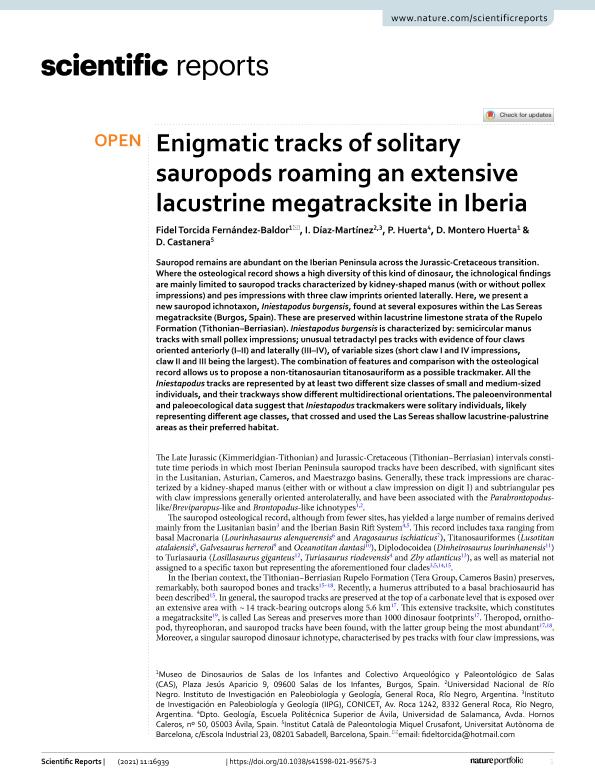Mostrar el registro sencillo del ítem
dc.contributor.author
Torcida Fernández Baldor, Fidel
dc.contributor.author
Díaz Martínez, Ignacio

dc.contributor.author
Huerta, P.
dc.contributor.author
Montero Huerta, D.
dc.contributor.author
Castanera, D.
dc.date.available
2023-01-05T12:06:46Z
dc.date.issued
2021-12
dc.identifier.citation
Torcida Fernández Baldor, Fidel; Díaz Martínez, Ignacio; Huerta, P.; Montero Huerta, D.; Castanera, D.; Enigmatic tracks of solitary sauropods roaming an extensive lacustrine megatracksite in Iberia; Nature; Scientific Reports; 11; 1; 12-2021; 1-17
dc.identifier.issn
2045-2322
dc.identifier.uri
http://hdl.handle.net/11336/183462
dc.description.abstract
Sauropod remains are abundant on the Iberian Peninsula across the Jurassic-Cretaceous transition. Where the osteological record shows a high diversity of this kind of dinosaur, the ichnological findings are mainly limited to sauropod tracks characterized by kidney-shaped manus (with or without pollex impressions) and pes impressions with three claw imprints oriented laterally. Here, we present a new sauropod ichnotaxon, Iniestapodus burgensis, found at several exposures within the Las Sereas megatracksite (Burgos, Spain). These are preserved within lacustrine limestone strata of the Rupelo Formation (Tithonian–Berriasian). Iniestapodus burgensis is characterized by: semicircular manus tracks with small pollex impressions; unusual tetradactyl pes tracks with evidence of four claws oriented anteriorly (I–II) and laterally (III–IV), of variable sizes (short claw I and IV impressions, claw II and III being the largest). The combination of features and comparison with the osteological record allows us to propose a non-titanosaurian titanosauriform as a possible trackmaker. All the Iniestapodus tracks are represented by at least two different size classes of small and medium-sized individuals, and their trackways show different multidirectional orientations. The paleoenvironmental and paleoecological data suggest that Iniestapodus trackmakers were solitary individuals, likely representing different age classes, that crossed and used the Las Sereas shallow lacustrine-palustrine areas as their preferred habitat.
dc.format
application/pdf
dc.language.iso
eng
dc.publisher
Nature

dc.rights
info:eu-repo/semantics/openAccess
dc.rights.uri
https://creativecommons.org/licenses/by/2.5/ar/
dc.subject
Iniestapodus
dc.subject
sauropod tracks
dc.subject
Lower Cretaceous
dc.subject
Cameros Basin
dc.subject.classification
Paleontología

dc.subject.classification
Ciencias de la Tierra y relacionadas con el Medio Ambiente

dc.subject.classification
CIENCIAS NATURALES Y EXACTAS

dc.title
Enigmatic tracks of solitary sauropods roaming an extensive lacustrine megatracksite in Iberia
dc.type
info:eu-repo/semantics/article
dc.type
info:ar-repo/semantics/artículo
dc.type
info:eu-repo/semantics/publishedVersion
dc.date.updated
2022-09-20T10:47:43Z
dc.journal.volume
11
dc.journal.number
1
dc.journal.pagination
1-17
dc.journal.pais
Reino Unido

dc.description.fil
Fil: Torcida Fernández Baldor, Fidel. Chinese Academy of Sciences; República de China
dc.description.fil
Fil: Díaz Martínez, Ignacio. Consejo Nacional de Investigaciones Científicas y Técnicas. Centro Científico Tecnológico Conicet - Patagonia Norte. Instituto de Investigación en Paleobiología y Geología; Argentina
dc.description.fil
Fil: Huerta, P.. Universidad de Salamanca; España
dc.description.fil
Fil: Montero Huerta, D.. Chinese Academy of Sciences; República de China
dc.description.fil
Fil: Castanera, D.. Universitat Autònoma de Barcelona; España
dc.journal.title
Scientific Reports
dc.relation.alternativeid
info:eu-repo/semantics/altIdentifier/doi/http://dx.doi.org/10.1038/s41598-021-95675-3
Archivos asociados
